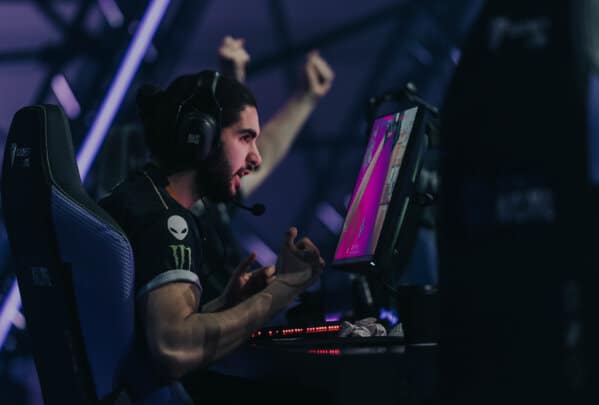The first year of the VALORANT Champions Tour has given a good insight into the young scene. Will Riots Shooter prevail?
Born in a very competitive shooter market and with competitors like CS:GO and Rainbow Six, VALORANT had some catching up to do. With a reputation as a “CS:GO clone” and “retirement home” for former CS:GO and Overwatch players, it was doubtful that the scene could really grow.
Under Nerd Street Gamers’ watch, VALORANT’s viewership steadily increased. Riot’s young VCT plan then shot the numbers to new heights, the highlight now being the Masters in Reykjavik. The incredible growth makes one think. Is VALORANT slowly taking over the esports scene?
Table of Contents
VALORANT’s exponential growth
The first Riot Games sanctioned event First Strike drove viewer numbers to new heights. On Twitch alone, an average of 94,000 fans watched, peaking at more than 300,000 during the finale between 100Thieves and TSM, unimaginable numbers compared to qualifiers and events from third-party promoters like FaZe.
Overall probably the best day in VALORANT ever. New peak viewership over 740k. @itsPatiphan pushed Brazil's best. V1 mindgamed TL into oblivion. Fnatic and Sentinels had a slugfest. Super close games
The hype is only going to build as Europe makes it back through lowers
— The Esports Writer (@FionnOnFire) May 26, 2021
Compared to the numbers just a few months later, this peak seems small again. So far, an average of 477,000 spectators have watched the Masters in Reykjavik, peaking at 747,000 for the match between Team Liquid and Version1. That’s surprising, because teams like Version1 or Crazy Raccoon are still relatively small and unknown.
Besides, we are only halfway through the tournament. If the numbers keep rising like this, new records could be set at the final.
without shroud's costream Valorant BR VCT has more viewers and engagement than Valorant NA. Brasil beating NA in skill and community pic.twitter.com/CZau9RLKRX
— Rod Breslau (@Slasher) March 21, 2021
What’s also changing is the demographic breakdown of spectators. For a long time, North America was the biggest fanbase in VALORANT. Before the Masters, the region alone provided 43.8% of the total audience. However, with international tournament participants, regions such as Japan, North Korea and Latin America have now grown significantly. How exactly did Riot achieve such growth in an esport that has stagnated in the meantime?
Co-Streams are the key
Since League of Legends, certain partnered streamers have been allowed to watch matches live with their community while streaming. For leagues with declining viewership like the LCS, these co-streams finally brought back the desired viewership. This practice has also had the desired effect in VALORANT and is the main reason for the high numbers.
Well-known personalities like Myth and Ninja had such a big impact on the scene, often having more viewers than the official streams. Accordingly, co-streams were also allowed for the VCT and the tournament in Iceland. Here, the former CS:GO pro shroud plays a big role in the success of the series. In the Sentinels vs. Fnatic match, his stream alone provided more than 272,000 viewers at the peak.
So fans love to watch the tournaments from the perspective of their favourite streamers. Riot has recognised this and allows the scene to benefit from the co-streams.
Masters Reykjavik write esport history
It’s not everyday you get to watch the making of a scene live. The Masters in Reykjavik is one such moment for VALORANT.
The game was released at a time when the pandemic meant that only isolated, regional scenes were created. Accordingly, audience numbers were often low due to regional restrictions in the early stages. While this was far from ideal for Riot’s esport plans, the distance simultaneously created excitement for the longed-for international tournaments.
Is VALORANT keeping up now?
The Masters Reykjavik are taking place at an interesting time. The first international VALORANT LAN takes place at the same time as tournaments of other big FPS games. Therefore we can compare them pretty well.
Flashpoint 3 is the most recent CS:GO tournament. Even though controversies surrounding the organisers play a role, the tournament shows the game’s declining viewership. Flashpoint has averaged 96,000 and maxed out at 254,000 viewers so far. The contrast becomes even clearer when comparing the event to its 2020 predecessor. IEM Masters has only seen a slight drop in average viewership compared to last year, but at its peak the tournament has reached half a million fewer viewers this year than last.
Rainbow Six, on the other hand, is a title that has so far failed to appeal to the masses, but is steadily gaining new fans. If we compare “The Invitational” with the Masters Reykjavik, R6 seems like the bigger competitor. The tournament reached 156,000 spectators on average and more than 306,000 at its peak. Even though the numbers are behind VALORANT, viewers seem to be slowly moving on from CS:GO since the beginning of the online era.
VALORANT currently seems to be in the lead. However, this position must also be held permanently. However, Riot already has a plan for this: Masters 3 is already scheduled as a live event in Berlin.


